2D Numerical Simulation of Improving Wellbore Stability in Shale Using Nanoparticles Based Drilling Fluid
Abstract
:1. Introduction
2. Pressure Transmission Tests on Shale
2.1. Experimental Materials
2.2. Methodology
2.3. PTT Results Analysis
2.3.1. Pore Fluid Pressure Transmission from Drilling Fluid to Shale
2.3.2. The Influence of NP on Shale Permeability
3. Numerical Simulation Parameters for Wellbore Stability Analysis
4. Results and Discussion
4.1. Pore Fluid Pressure Transmission Simulation of Shale with the Invasion of Drilling Fluid
4.1.1. The Law of Pore Fluid Pressure Transmission of Shale in Contact with Sea Water
4.1.2. Influence of Drilling Fluid Density on the Transmission of Pore Fluid Pressure
4.1.3. The Influence of NP on the Transmission of Pore Fluid Pressure
4.2. The Influence of Drilling Fluid Invasion with or without NP on the Stress and Deformation of Surrounding Rock
4.2.1. Stress Distribution Law of Surrounding Rock with the Invasion of Sea Water
4.2.2. Deformation Distribution Law of Surrounding Rock with the Invasion of Sea Water
4.2.3. The Influence of Fluid Density on the Deformation of the Surrounding Rock
4.2.4. The Influence of SiO2 NP on the Stress and Deformation of the Surrounding Rock
5. Discussion
5.1. The Mechanism of Silica NP Stabilizing Shale
5.2. The Influence of the Underlying Discretization on the Simulation Results
6. Conclusions
- (1)
- The numerical simulation results showed that water from the water-based drilling fluids had a strong tendency to invade shale, driven by the positive pressure differential between drilling fluid pressure and pore fluid pressure which increased the likelihood of shale instability. However, the transmission of pore fluid pressure could be mitigated in the presence of silica NP, which is consistent with previous results of PTT. The pore pressure transmission boundary of the shale in contact with the drilling fluid could also be restricted with silica NP.
- (2)
- The stress differential and shear stress of surrounding rock near the wellbore can be reduced in the presence of NP. The plastic yield zone is minimized to improve wellbore stability.
- (3)
- The plugging of silica NP on the surface of the shale plays an important role in decreasing the permeability of shale. The plugging mechanism of NP may be attributed to the electrostatic and electrodynamic interaction between NP and shale surfaces, governed by DLVO forces, which allows the NP to approach shale surfaces and adhere to them.
- (4)
- Discretization of the simulation model is beneficial in distinguishing the yield zone distribution of the surrounding rock in shales.
Acknowledgments
Author Contributions
Conflicts of Interest
References
- Lal, M. Shale Stability: Drilling fluid interaction and shale strength. In Proceedings of the SPE Asia Pacific Oil and Gas Conference and Exhibition, Jakarta, Indonesia, 20–22 April 1999. [Google Scholar]
- Steiger, R.P.; Leung, P.K. Quantitative determination of the mechanical properties of shales. SPE Drill. Eng. 1992, 7, 181–185. [Google Scholar] [CrossRef]
- Van Oort, E.; Hale, A.H.; Mody, F.K.; Roy, S. Transport in shales and the design of improved water-based shale drilling fluids. SPE Drill. Complet. 1996, 11, 137–146. [Google Scholar] [CrossRef]
- Chenevert, M.E. Shale control with balanced-activity oil-continuous muds. J. Pet. Technol. 1970, 22, 1309–1316. [Google Scholar] [CrossRef]
- Ewy, R.T.; Morton, E.K. Wellbore-stability performance of water-based mud additives. SPE Drill. Complet. 2009, 24, 390–397. [Google Scholar] [CrossRef]
- Hayatdavoudi, A.; Apande, E. A theoretical analysis of wellbrore failure and stability in shales. In Proceedings of the 27th U.S. Symposium on Rock Mechanics, Tuscaloosa, AL, USA, 23–25 June 1986. [Google Scholar]
- Carminati, S.; Del Gaudio, L.; Brignoli, M. Shale stabilisation by pressure propagation prevention. In Proceedings of the SPE Annual Technical Conference and Exhibition, Dallas, TX, USA, 1–4 October 2000. [Google Scholar]
- Reid, P.I.; Dolan, B.; Cliffe, S. Mechanism of shale inhibition by polyols in water-based drilling fluids. In Proceedings of the SPE International Symposium on Oilfield Chemistry, San Antonio, TX, USA, 14–17 February 1995. [Google Scholar]
- Zhong, H.; Qiu, Z.; Huang, W.; Cao, J. Shale inhibitive properties of polyether diamine in water-based drilling fluid. J. Pet. Sci. Eng. 2011, 78, 510–515. [Google Scholar] [CrossRef]
- Van Oort, E.; Pasturel, C.; Bryla, J.; Ditlevsen, F. Improved wellbore stability in tor/ekofisk wells through shale-fluid compatibility optimization. In Proceedings of the SPE/IADC Drilling Conference and Exhibition, The Hague, The Netherlands, 14–16 March 2017. [Google Scholar]
- Al-Bazali, T.M.; Zhang, J.; Chenevert, M.E.; Sharma, M.M. Measurement of the sealing capacity of shale caprocks. In Proceedings of the SPE Annual Technical Conference and Exhibition, Dallas, TX, USA, 9–12 October 2005. [Google Scholar]
- Ambrose, R.J.; Hartman, R.C.; Diaz Campos, M.; Akkutlu, I.Y.; Sondergeld, C. New pore-scale considerations for shale gas in place calculations. In Proceedings of the SPE Unconventional Gas Conference, Pittsburgh, PA, USA, 23–25 February 2010. [Google Scholar]
- Milner, M.; McLin, R.; Petriello, J. Imaging texture and porosity in mudstones and shales: Comparison of secondary and ion-milled backscatter SEM methods. In Proceedings of the Canadian Unconventional Resources and International Petroleum Conference, Calgary, AB, Canada, 19–21 October 2010. [Google Scholar]
- Nelson, P.H. Pore-throat sizes in sandstones, tight sandstones, and shales. AAPG Bull. 2009, 93, 329–340. [Google Scholar] [CrossRef]
- Schieber, J. Common themes in the formation and preservation of intrinsic porosity in shales and mudstones-illustrated with examples across the phanerozoic. In Proceedings of the SPE Unconventional Gas Conference, Pittsburgh, PA, USA, 23–25 February 2010. [Google Scholar]
- Sondergeld, C.H.; Ambrose, R.J.; Rai, C.S.; Moncrieff, J. Micro-structural studies of gas shales. In Proceedings of the SPE Unconventional Gas Conference, Pittsburgh, PA, USA, 23–25 February 2010. [Google Scholar]
- Zou, C.; Zhu, R.; Bai, B.; Yang, Z.; Wu, S.; Su, L.; Dong, D.; Li, X. First discovery of nano-pore throat in oil and gas reservoir in China and its scientific value. Atca Petrol. Sin. 2011, 27, 1857–1864. [Google Scholar]
- Sensoy, T.; Chenevert, M.E.; Sharma, M.M. Minimizing water invasion in shales using nanoparticles. In Proceedings of the SPE Annual Technical Conference and Exhibition, New Orleans, LA, USA, 4–7 October 2009. [Google Scholar]
- Cai, J.; Chenevert, M.E.; Sharma, M.M.; Friedheim, J.E. Decreasing water invasion into Atoka shale using nonmodified silica nanoparticles. SPE Drill. Complet. 2012, 27, 103–110. [Google Scholar] [CrossRef]
- Sharma, M.M.; Chenevert, M.E.; Guo, Q.; Ji, L.; Friedheim, J.; Zhang, R. A new family of nanoparticle based drilling fluids. In Proceedings of the SPE Annual Technical Conference and Exhibition, San Antonio, TX, USA, 8–10 October 2012. [Google Scholar]
- Hareland, G.; Wu, A.; Lei, L.; Husein, M.M.; Zakaria, M.F. Innovative nanoparticle drilling fluid and its benefits to horizontal or extended reach drilling. In Proceedings of the SPE Canadian Unconventional Resources Conference, Calgary, AB, Canada, 30 October–1 November 2012. [Google Scholar]
- Ji, L.; Guo, Q.; Friedheim, J.E.; Zhang, R.; Chenevert, M.E.; Sharma, M.M. Laboratory evaluation and analysis of physical shale inhibition of an innovative water-based drilling fluid with nanoparticles for drilling unconventional shales. In Proceedings of the SPE Asia Pacific Oil and Gas Conference and Exhibition, Perth, Australia, 22–24 October 2012. [Google Scholar]
- Zakaria, M.; Husein, M.M.; Harland, G. Novel nanoparticle-based drilling fluid with improved characteristics. In Proceedings of the SPE International Oilfield Nanotechnology Conference and Exhibition, Noordwijk, The Netherlands, 12–14 June 2012. [Google Scholar]
- Akhtarmanesh, S.; Shahrabi, M.J.A.; Atashnezhad, A. Improvement of wellbore stability in shale using nanoparticles. J. Pet. Sci. Eng. 2013, 112, 290–295. [Google Scholar] [CrossRef]
- Pandey, P.; Kapadnis, P.P.; Ghansar, B.H.; Mandan, S.P. Thermoelectric nanomaterial: A demiurgic approach towards improvement of shale stability. In Proceedings of the SPE Unconventional Gas Conference and Exhibition, Muscat, Oman, 28–30 January 2013. [Google Scholar]
- Jung, C.M.; Zhang, R.; Chenevert, M.; Sharma, M. High-performance water-based mud using nanoparticles for shale reservoirs. In Proceedings of the Unconventional Resources Technology Conference, Denver, CO, USA, 12–14 August 2013. [Google Scholar]
- Liang, C.; Chen, M.; Lu, B.; Wang, J.; Jin, Y.; Yang, S.; Hou, X.; Hou, B. The study of nano sealing to improve the brittle shale wellbore stability under dynamic load. In Proceedings of the Offshore Technology Conference Asia, Kuala Lumpur, Malaysia, 25–28 March 2014. [Google Scholar]
- Yang, X.; Yue, Y.; Cai, J.; Liu, Y.; Wu, X. Experimental study and stabilization mechanisms of silica nanoparticles based brine mud with high temperature resistance for horizontal shale gas wells. J. Nanomater. 2015, 2015, 745312. [Google Scholar] [CrossRef]
- Cedola, A.E.; Akhtarmanesh, S.; Qader, R.; Caldarola, V.T.; Hareland, G.; Nygaard, R.; Alsaba, M. Nanoparticles in weighted water-based drilling fluids increase loss gradient. In Proceedings of the 50th U.S. Rock Mechanics/Geomechanics Symposium, Houston, TX, USA, 26–29 June 2016. [Google Scholar]
- Gao, C.; Miska, S.Z.; Yu, M.; Ozbayoglu, E.M.; Takach, N.E. Effective enhancement of wellbore stability in shales with new families of nanoparticles. In Proceedings of the SPE Deepwater Drilling and Completions Conference, Galveston, TX, USA, 14–15 September 2016. [Google Scholar]
- Ghanbari, S.; Naderifar, A. Enhancing the physical plugging behavior of colloidal silica nanoparticles using binomial size distribution. J. Nat. Gas Sci. Eng. 2016, 30, 213–220. [Google Scholar] [CrossRef]
- Van Oort, E.; Hoxha, B.B.; Hale, A.; Aldin, M.; Patterson, R. How to test fluids for shale compatibility. In Proceedings of the AADE Fluids Technical Conference and Exhibition, Houston, TX, USA, 12–13 April 2016. [Google Scholar]
- Hoxha, B.B.; van Oort, E.; Daigle, H. How do nanoparticles stabilize shale? In Proceedings of the SPE International Conference on Oilfield Chemistry, Montgomery, TX, USA, 3–5 April 2017. [Google Scholar]
- Frydman, M.; da Fontoura, S.A.B. Modeling aspects of wellbore stability in shales. In Proceedings of the SPE Latin American and Caribbean Petroleum Engineering Conference, Buenos Aires, Argentina, 25–28 March 2001. [Google Scholar]
- Yu, M.; Chenevert, M.E.; Sharma, M.M. Chemical–mechanical wellbore instability model for shales: Accounting for solute diffusion. J. Pet. Sci. Eng. 2003, 38, 131–143. [Google Scholar] [CrossRef]
- Zhai, Z.; Zaki, K.S.; Marinello, S.A.; Abou-Sayed, A.S. Coupled thermoporomechanical effects on borehole stability. In Proceedings of the SPE Annual Technical Conference and Exhibition, New Orleans, LA, USA, 4–7 October 2009. [Google Scholar]
- Zhai, Z.; Abou-Sayed, A.S. Fully coupled chemical-thermal-poro-mechanical effect on borehole stability. In Proceedings of the Brasil Offshore, Macaé, Brazil, 14–17 June 2011. [Google Scholar]
- Huang, L.; Yu, M.; Miska, S.; Takach, N.; Green, A.; Bloys, B. Determination of safe salinity window in drilling shale formation. In Proceedings of the 46th U.S. Rock Mechanics/Geomechanics Symposium, Chicago, IL, USA, 24–27 June 2012. [Google Scholar]
- Wang, Q.; Zhou, Y.; Wang, G.; Jiang, H.; Liu, Y. A fluid-solid-chemistry coupling model for shale wellbore stability. Pet. Explor. Dev. 2012, 39, 508–513. [Google Scholar] [CrossRef]
- Wen, H.; Chen, M.; Jin, Y.; Wang, K.; Xia, Y.; Dong, J.; Niu, C. A chemo-mechanical coupling model of deviated borehole stability in hard brittle shale. Pet. Explor. Dev. 2014, 41, 817–823. [Google Scholar] [CrossRef]
- Zhuang, X.; Huang, R.; Liang, C.; Rabczuk, T. A coupled thermo-hydro-mechanical model of jointed hard rock for compressed air energy storage. Math. Probl. Eng. 2014, 2014, 179169. [Google Scholar] [CrossRef]
- Zhu, H.H.; Wang, Q.; Zhuang, X.Y. A nonlinear semi-concurrent multiscale method for fractures. Int. J. Impact Eng. 2016, 87, 65–82. [Google Scholar] [CrossRef]
- Chenevert, M.E.; Amanullah, M. Shale preservation and testing techniques for borehole-stability studies. SPE Drill. Complet. 2001, 16, 146–149. [Google Scholar] [CrossRef]
- Mody, F.K.; Tare, U.A.; Tan, C.P.; Drummond, C.J.; Wu, B. Development of novel membrane efficient water-based drilling fluids through fundamental understanding of osmotic membrane generation in shales. In Proceedings of the SPE Annual Technical Conference and Exhibition, San Antonio, TX, USA, 29 September–2 October 2002. [Google Scholar]
- AL-Bazali, T.M. Experimental Study of the Membrane Behavior of Shale during Interaction with Water-Based and Oil-Based Muds. Ph.D. Thesis, University of Texas at Austin, Austin, TX, USA, 2005. [Google Scholar]
- Van Oort, E. Physico-chemical stabilization of shales. In Proceedings of the International Symposium on Oilfield Chemistry, Houston, TX, USA, 18–21 February 1997. [Google Scholar]
- Rutqvist, J.; Wu, Y.S.; Tsang, C.F.; Bodvarsson, G. A modeling approach for analysis of coupled multiphase fluid flow, heat transfer, and deformation in fractured porous rock. Int. J. Rock Mech. Min. 2002, 39, 429–442. [Google Scholar] [CrossRef]
- Wu, C.; Luo, J.; Tian, R.; Liu, G.; Li, H.; Zhang, X. The effect of mud-shale hydration on rock mechanic parameters. J. Oil Gas Technol. 2012, 34, 147–150. [Google Scholar]
- Yang, J.; Fu, Y.; Chen, H.; Zeng, L.; Li, J. Rock mechanical characteristics of shale reservoirs. Nat. Gas Ind. 2012, 32, 12–14. [Google Scholar]
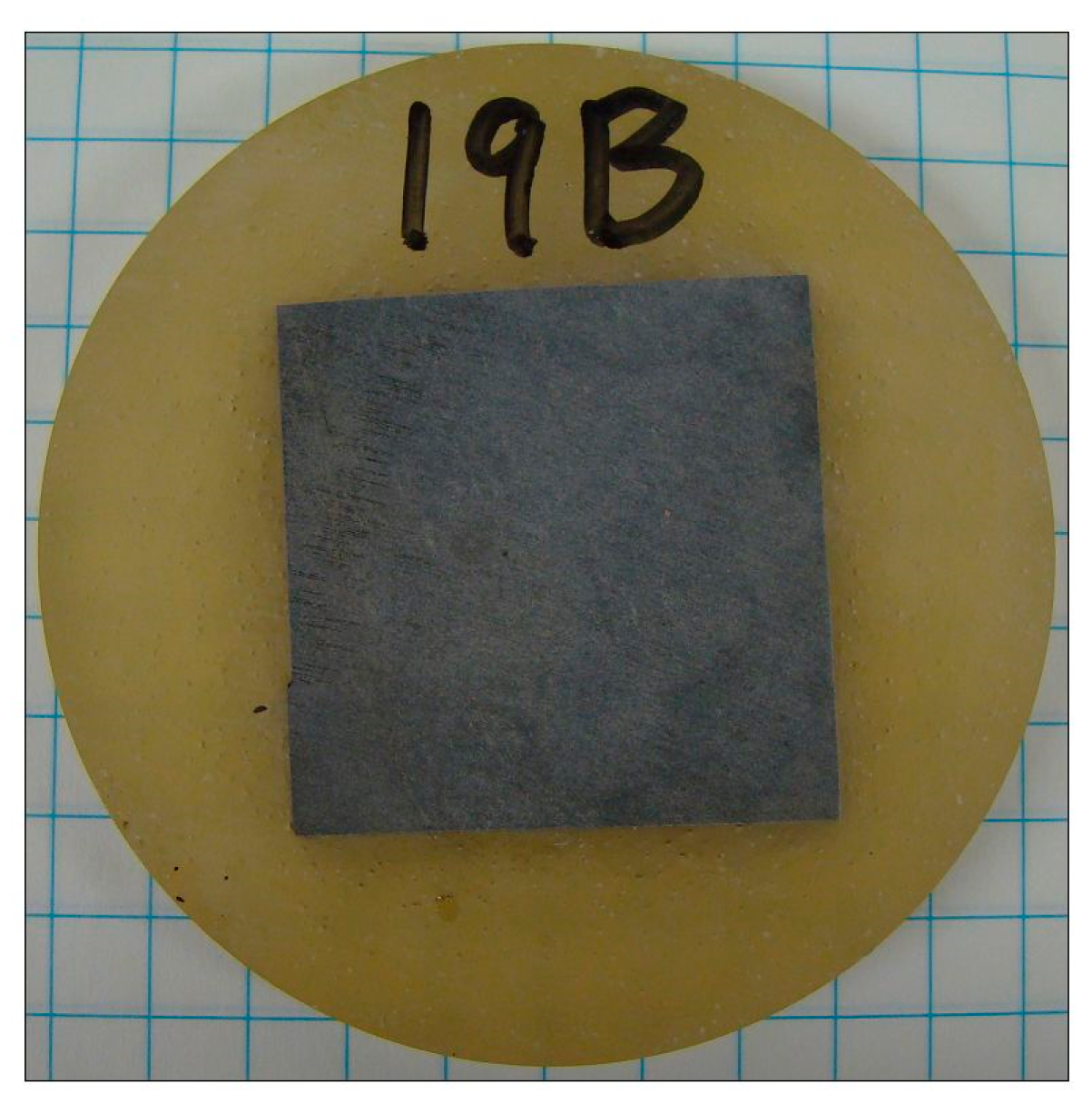

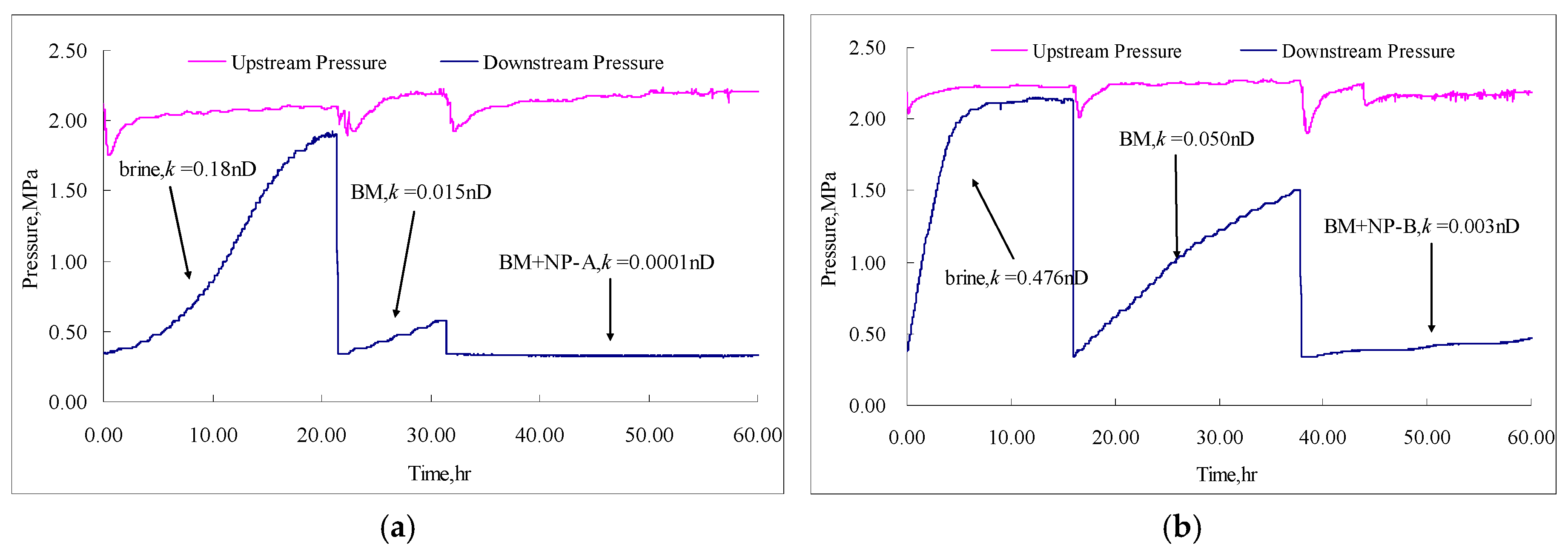

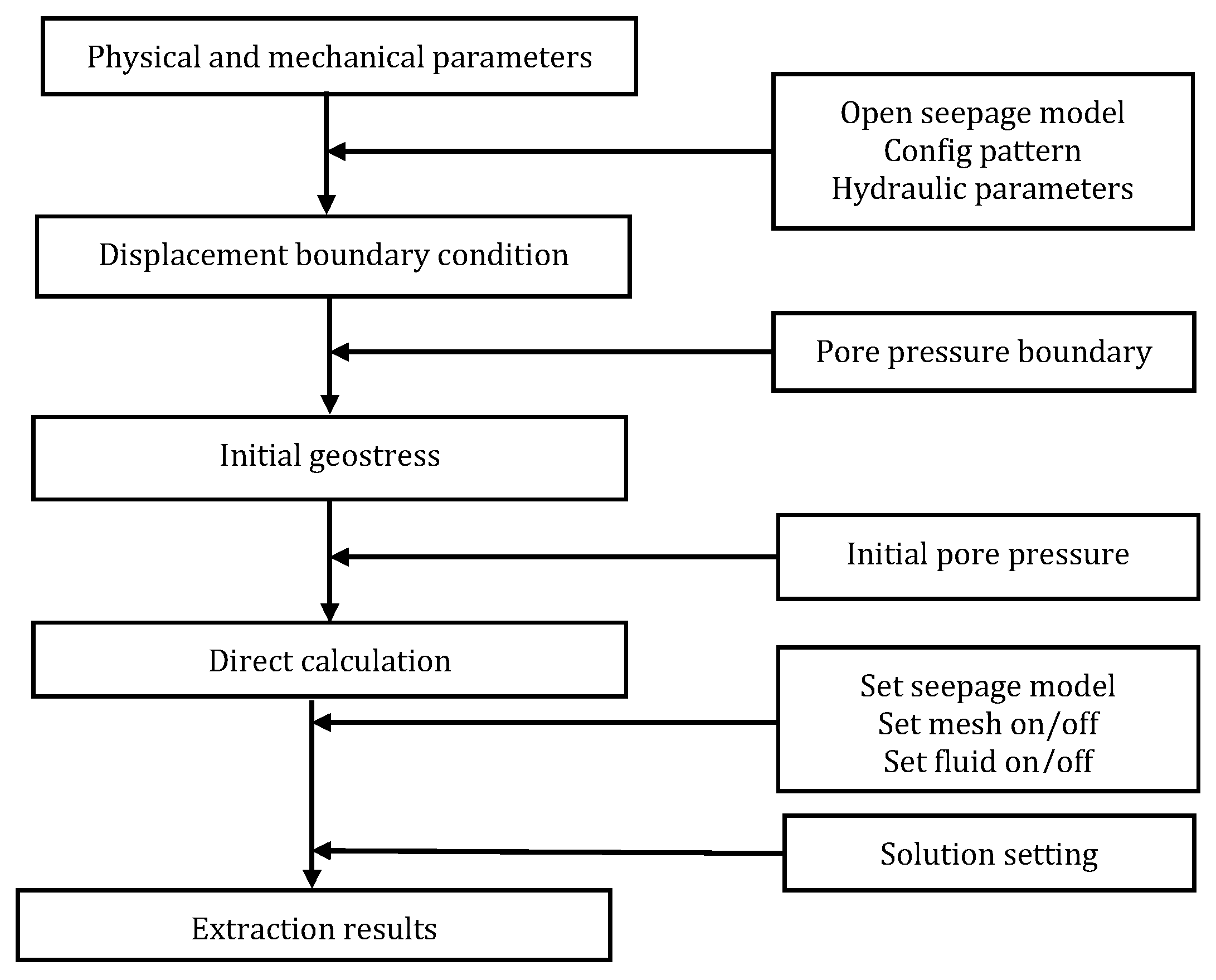
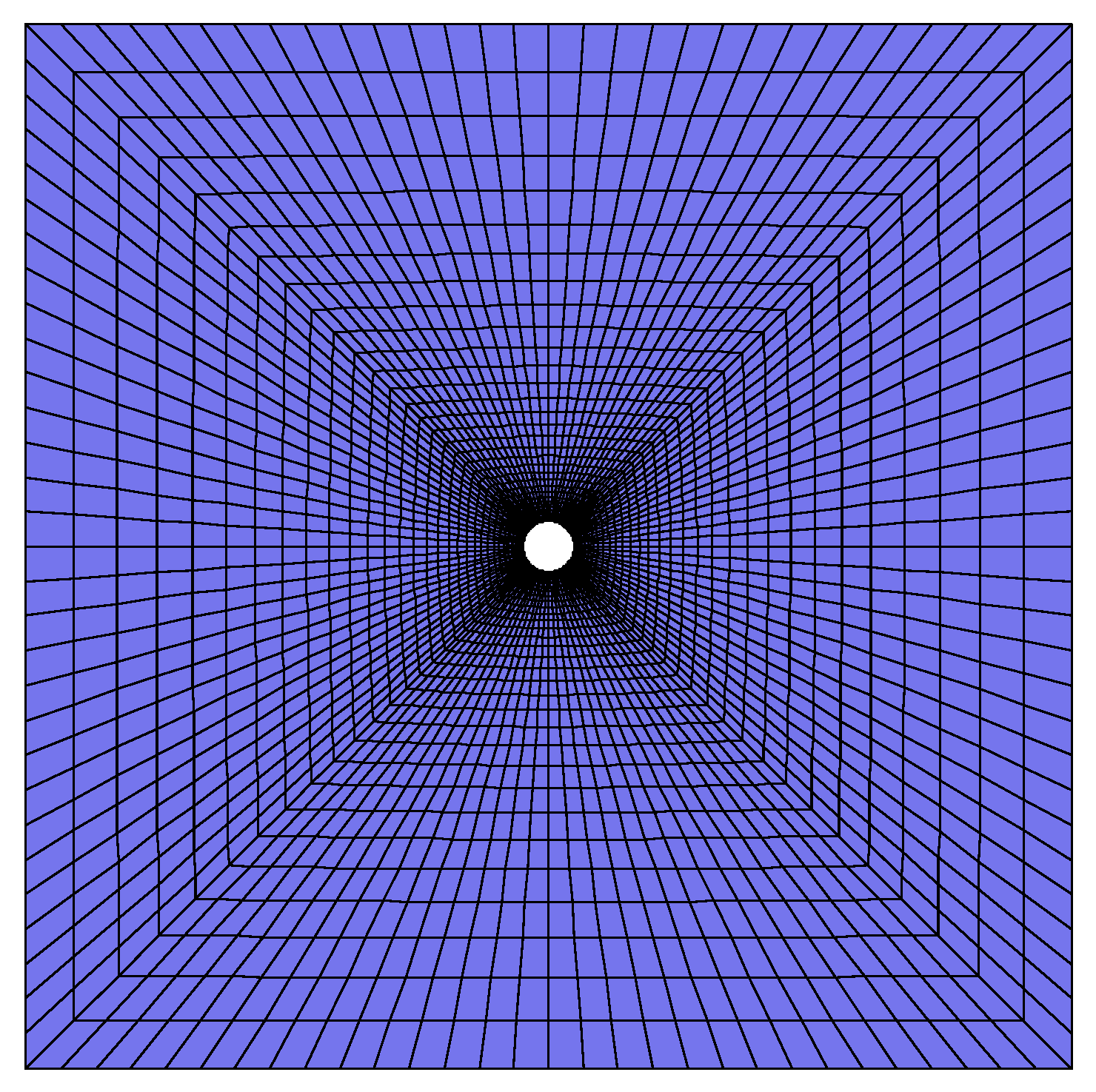
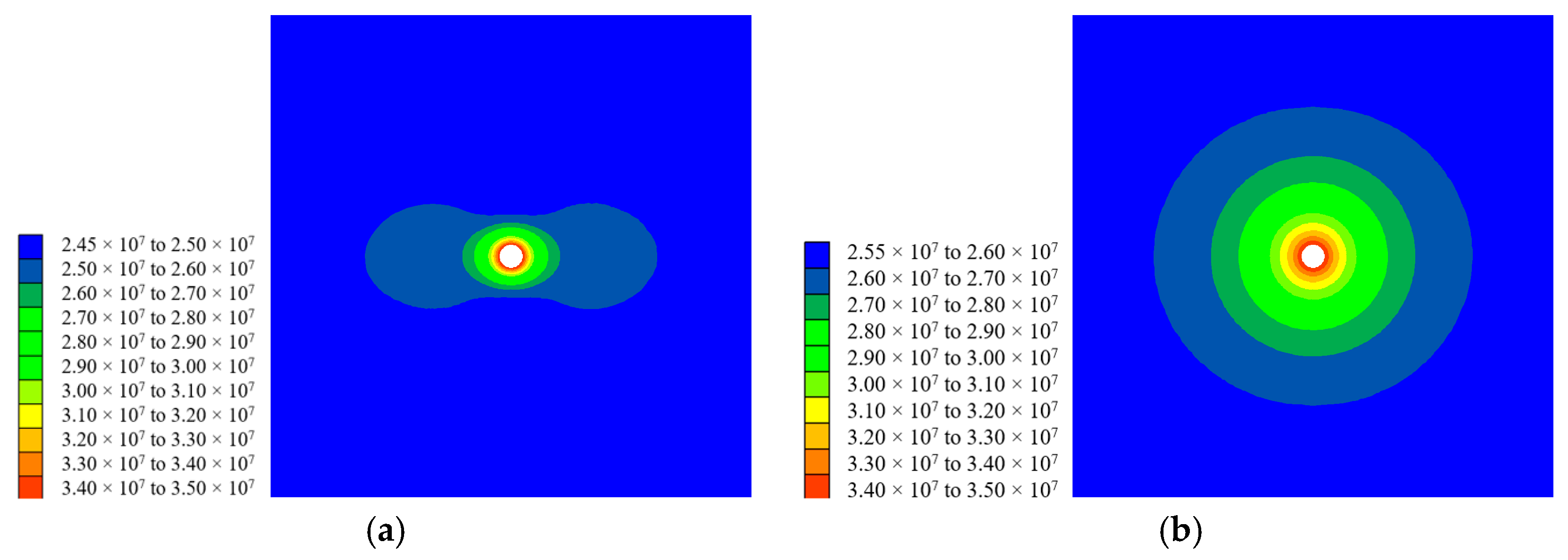

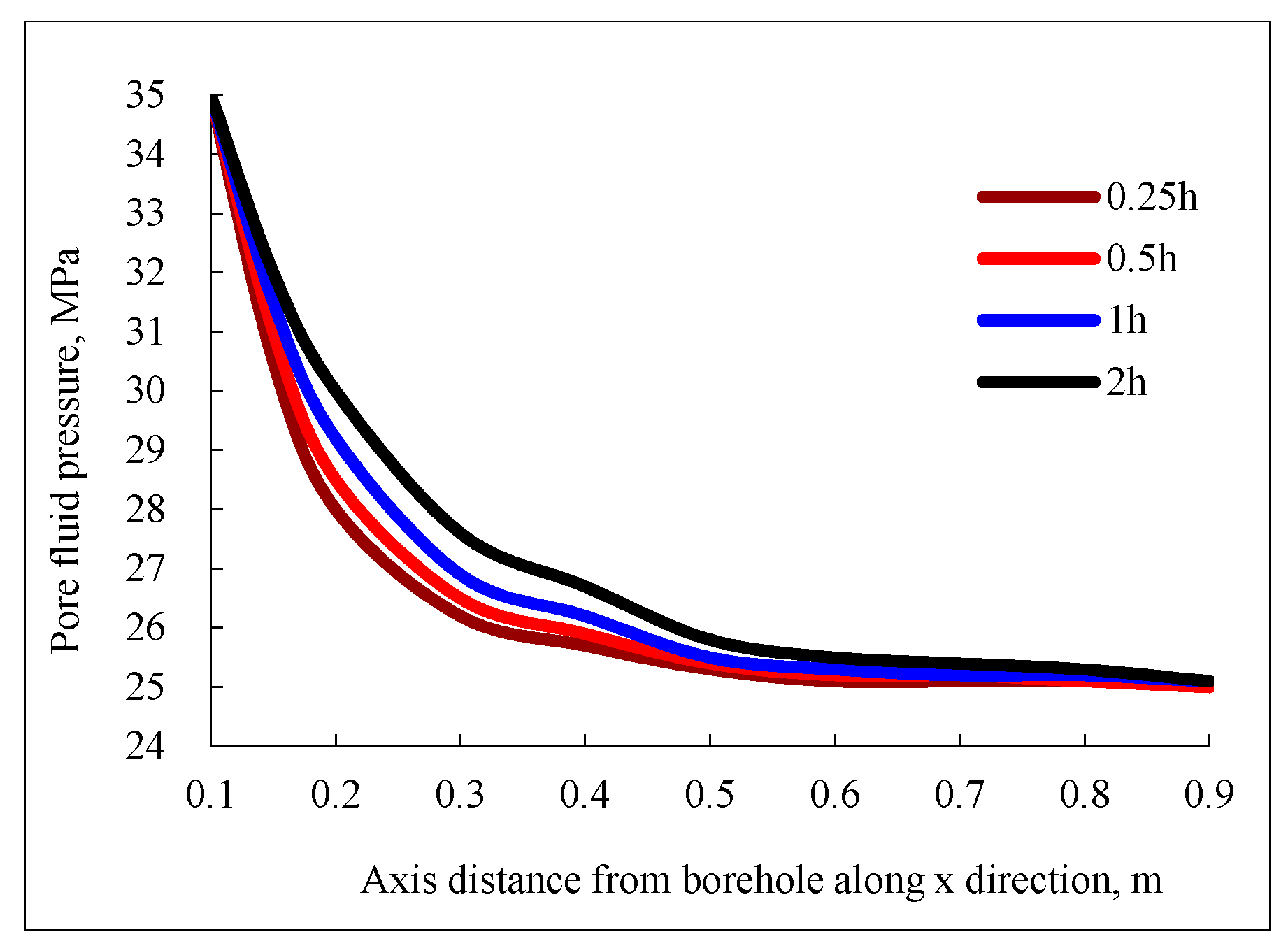
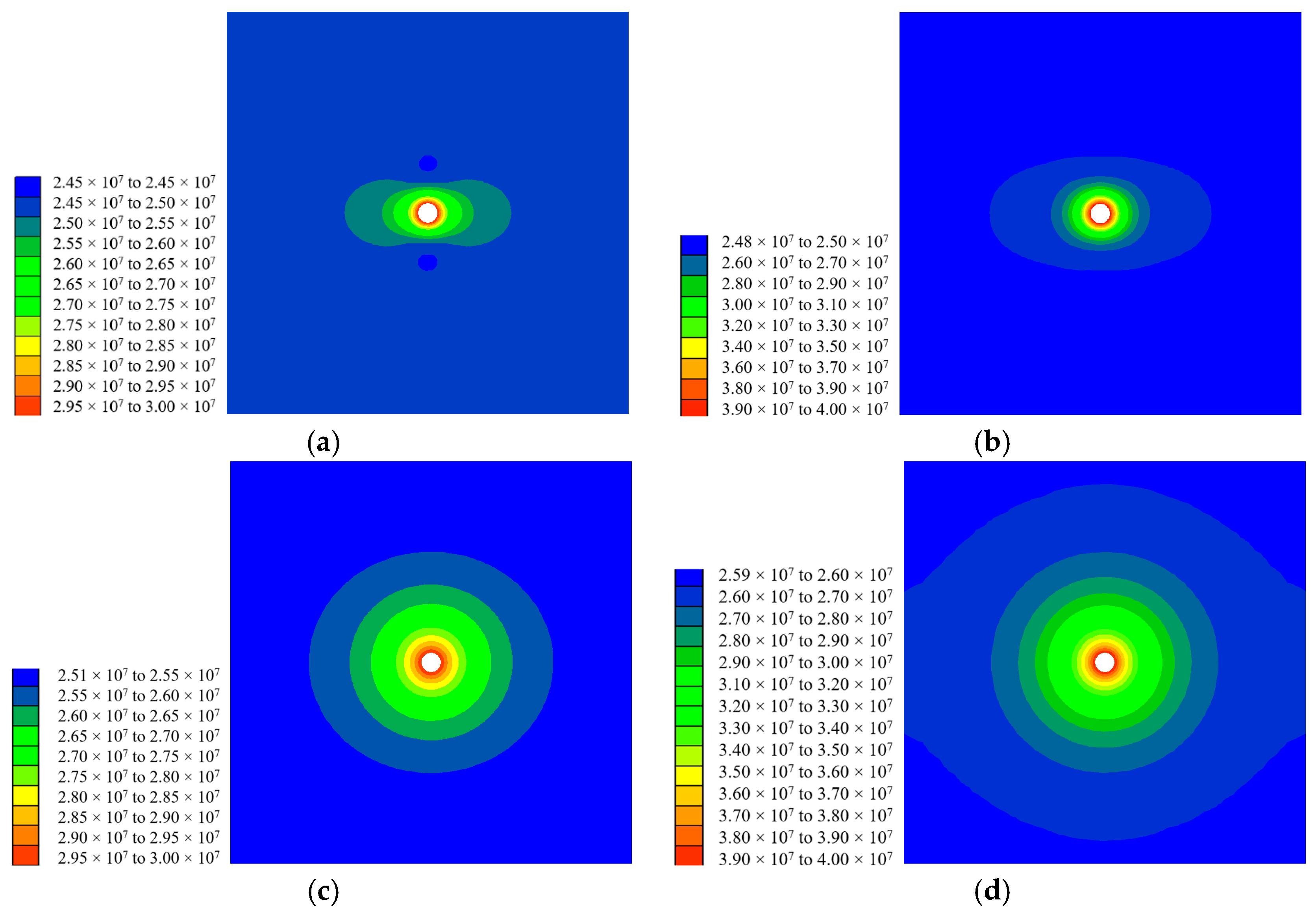




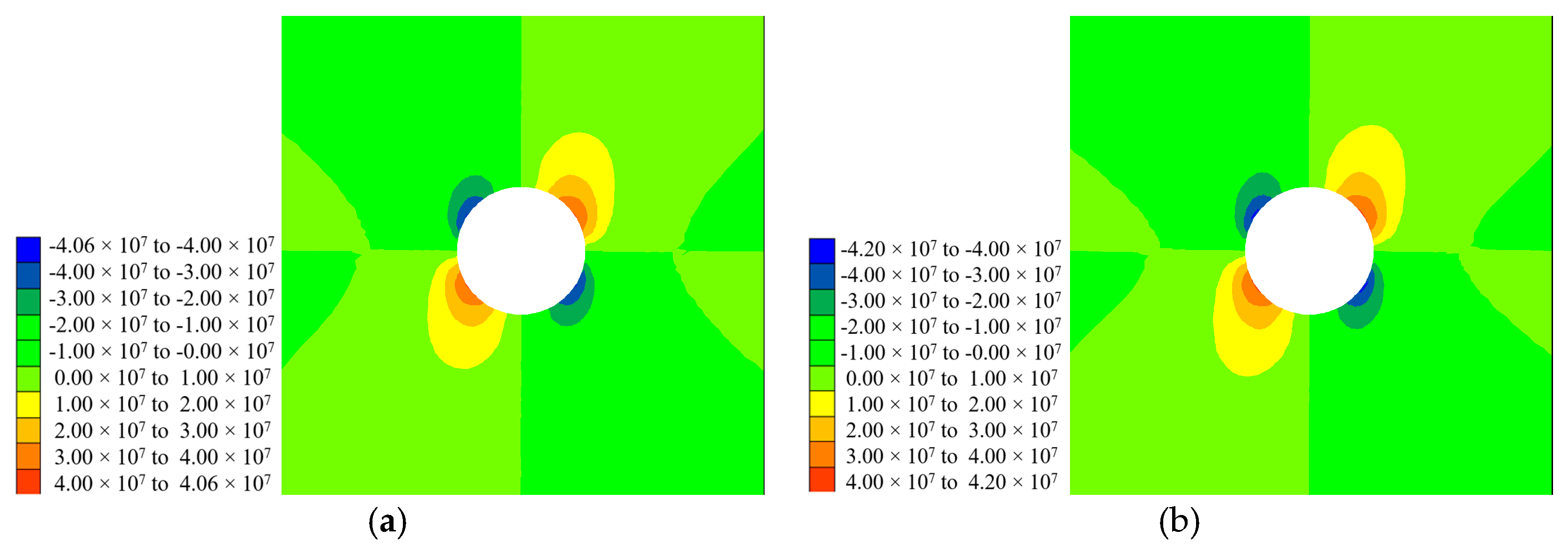
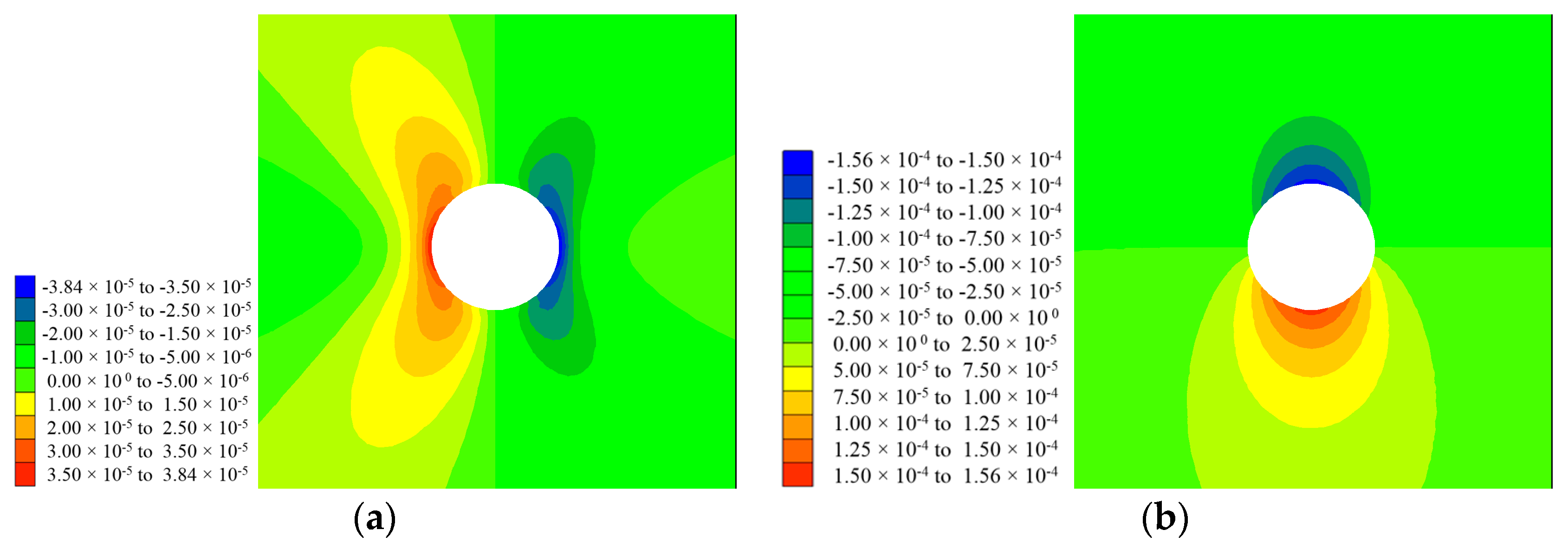
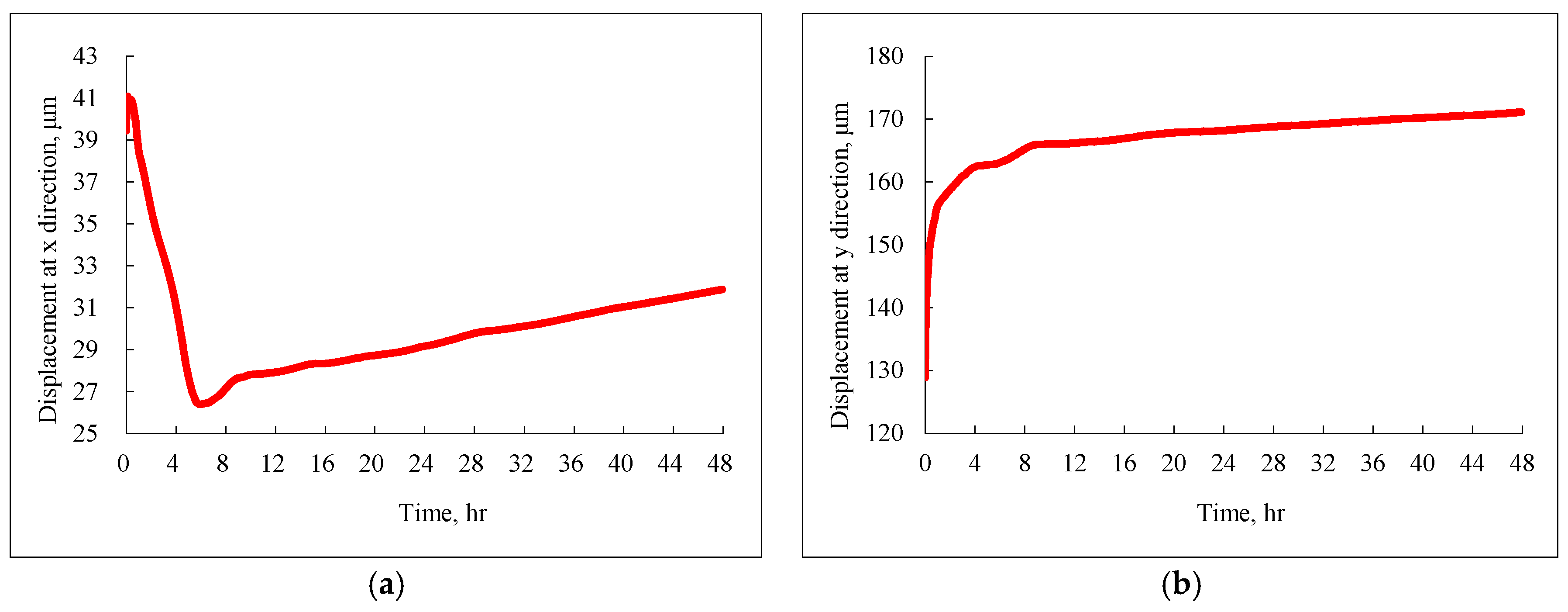
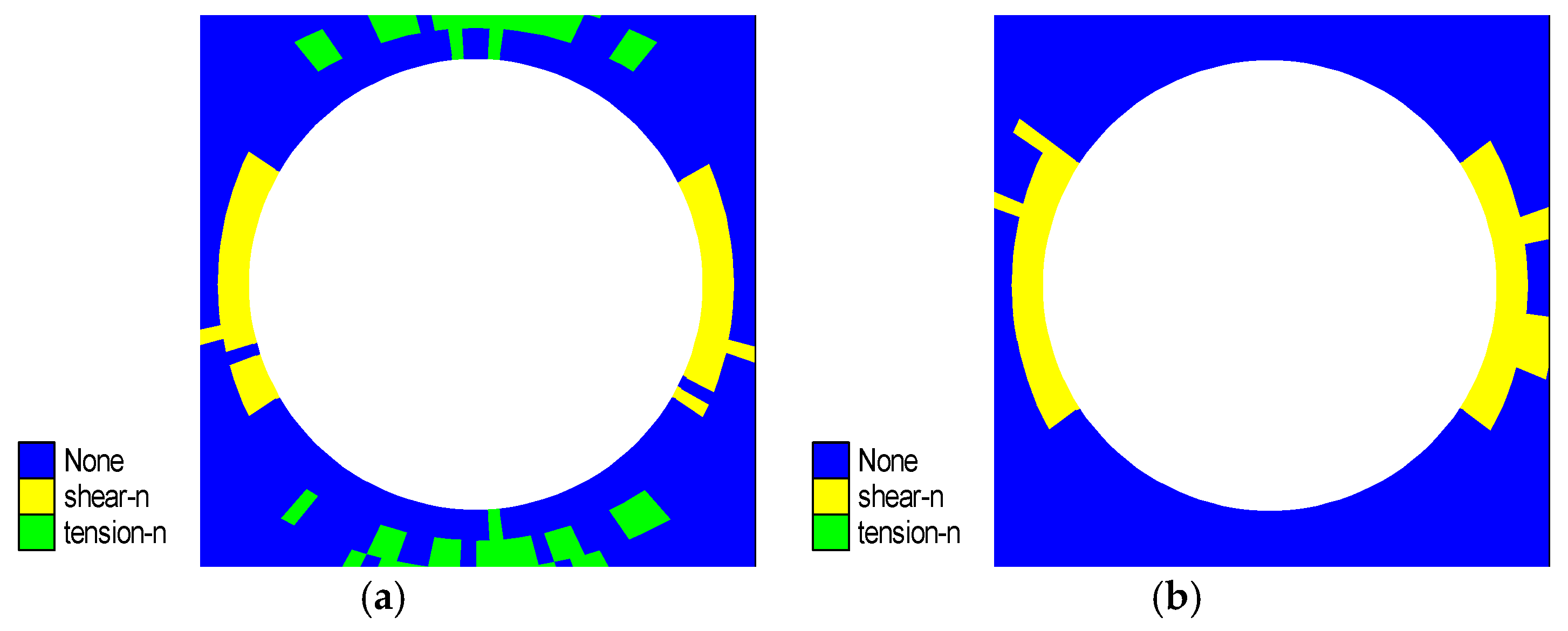
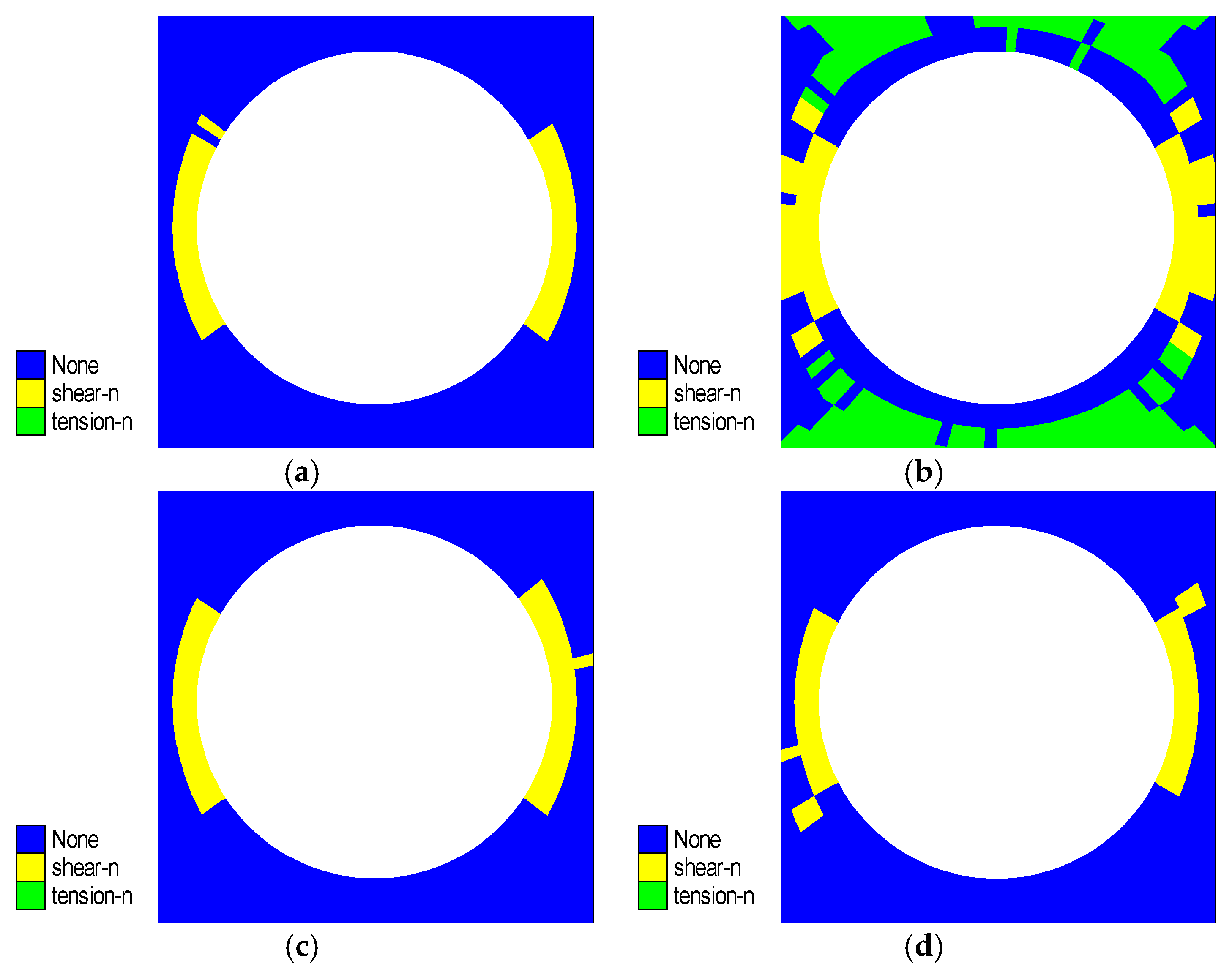
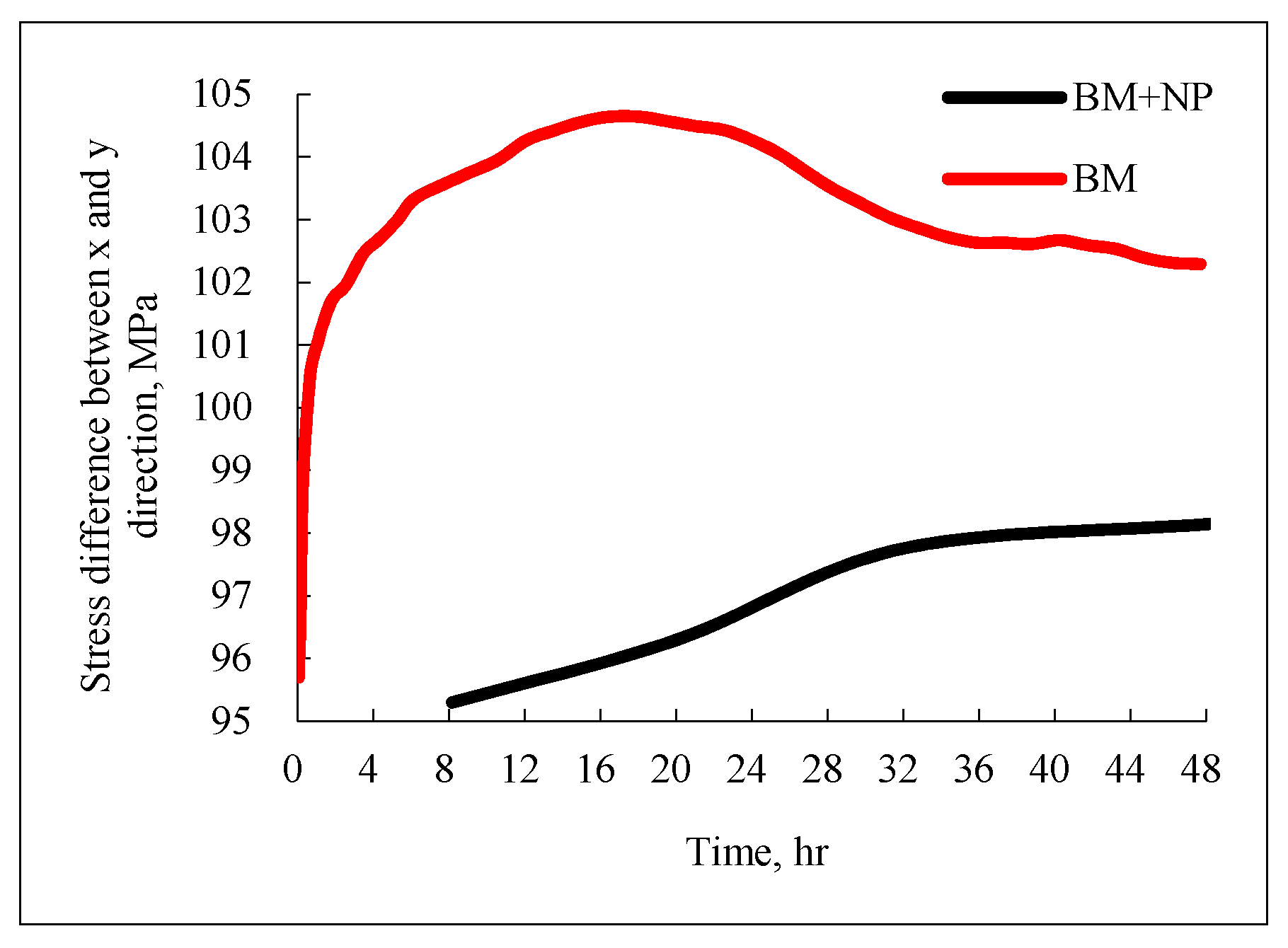
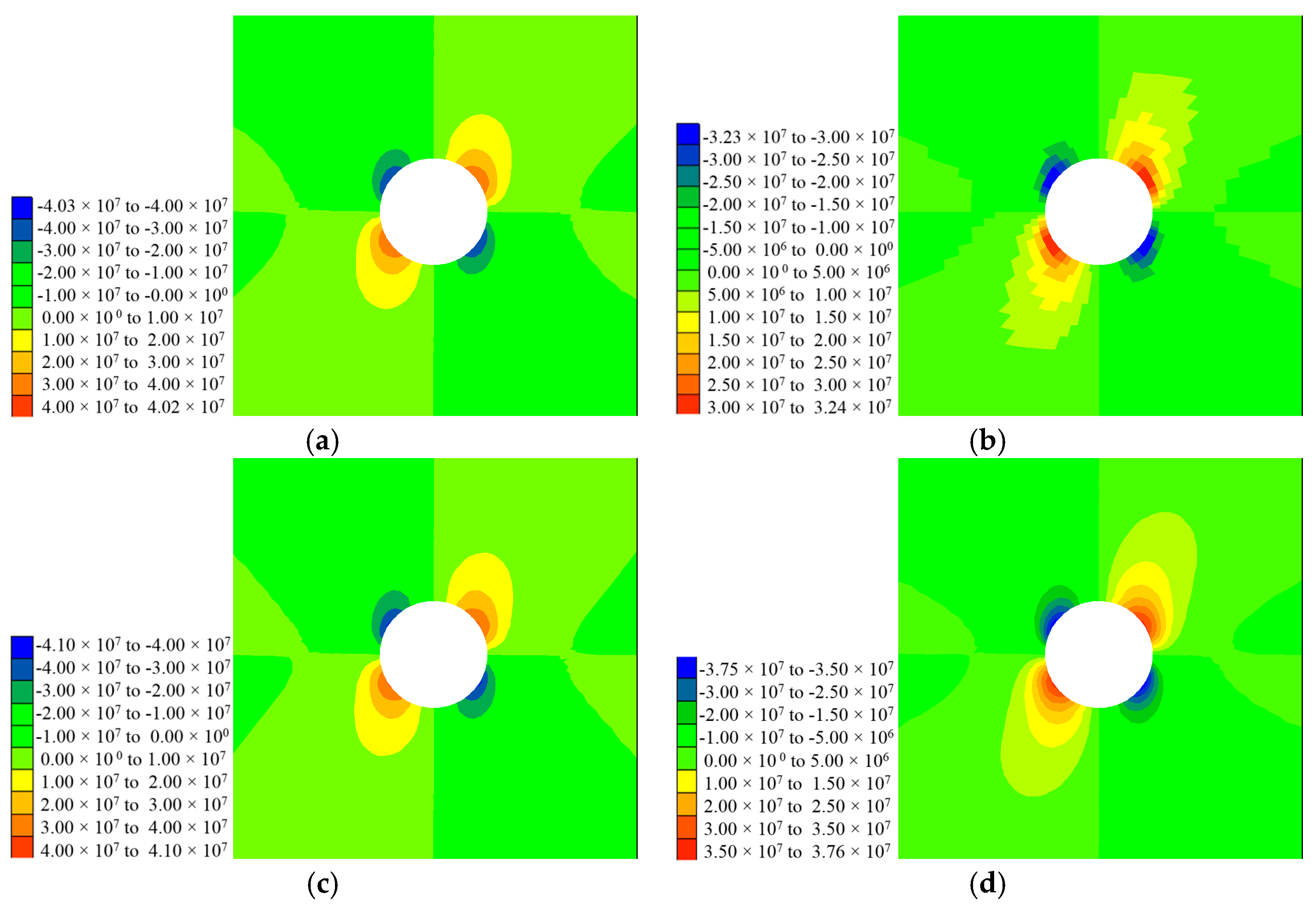
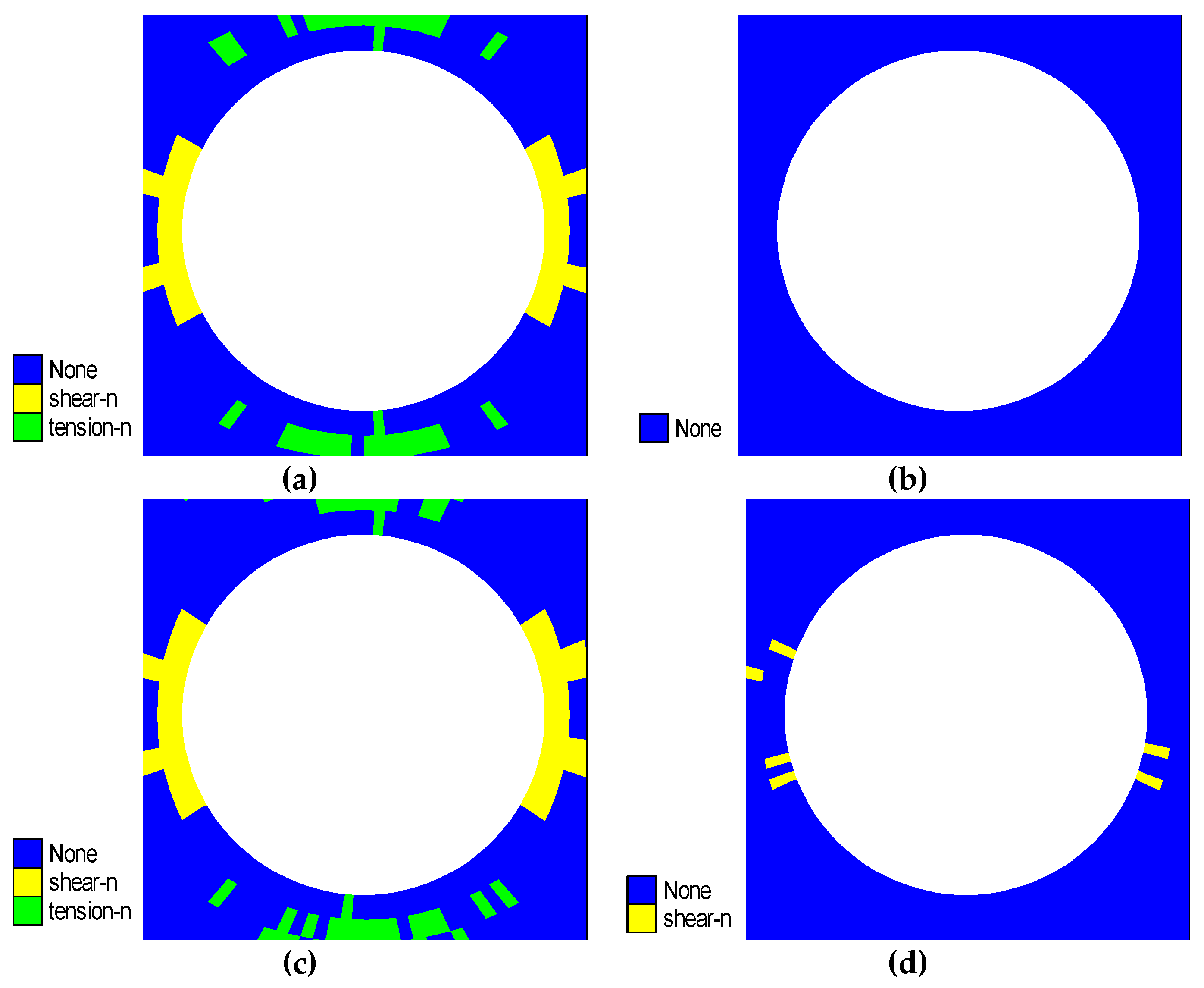
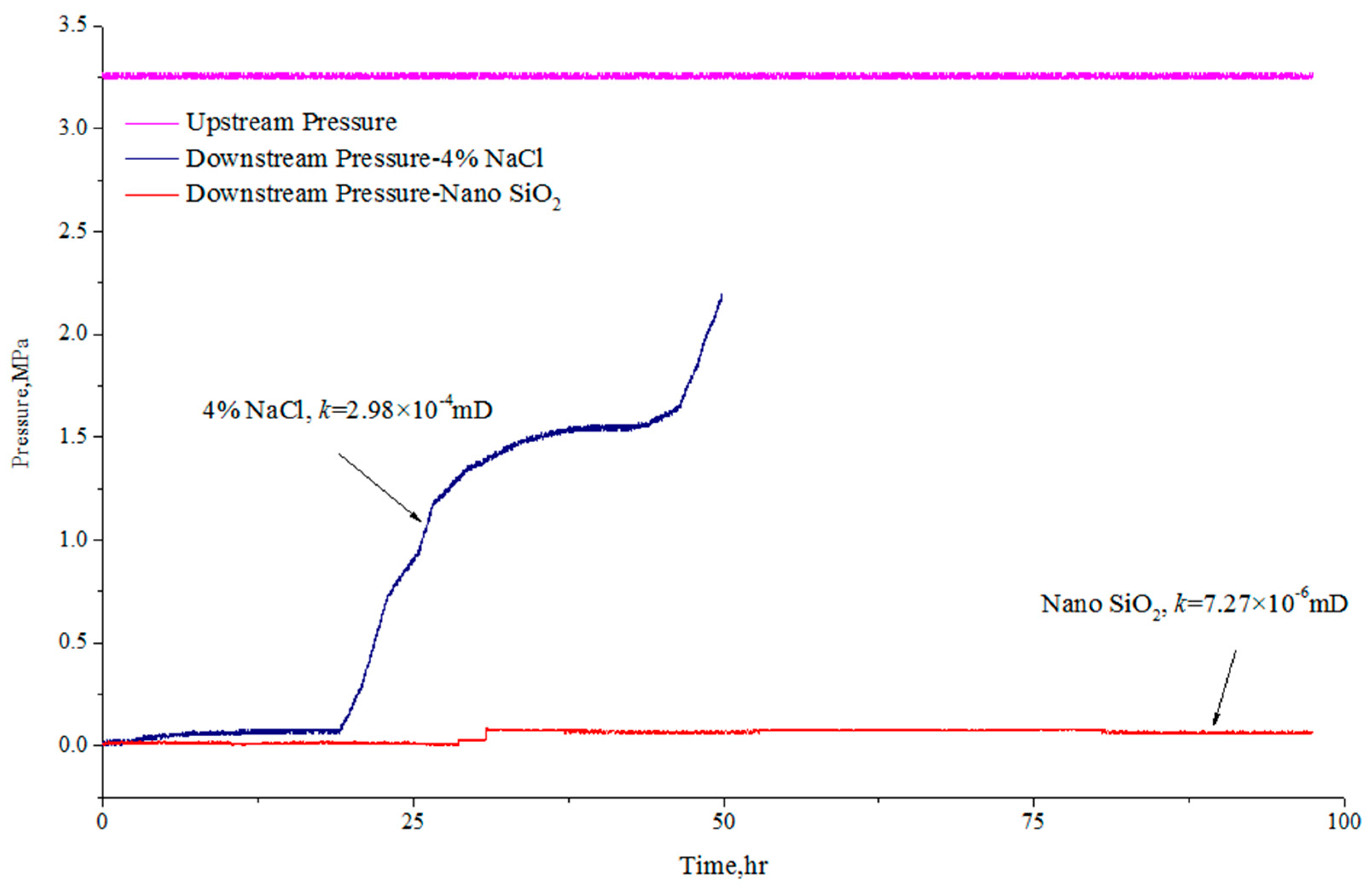
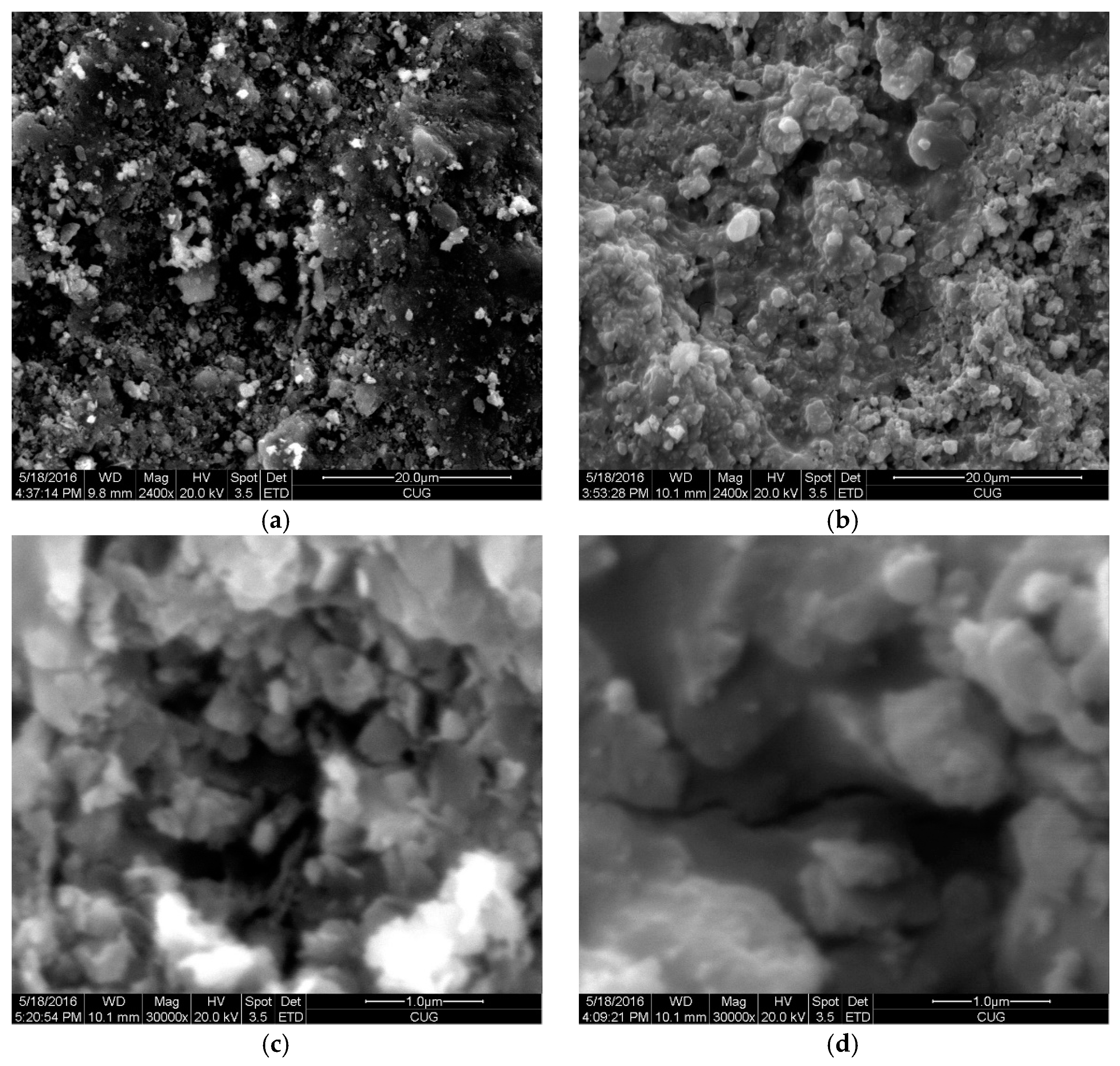

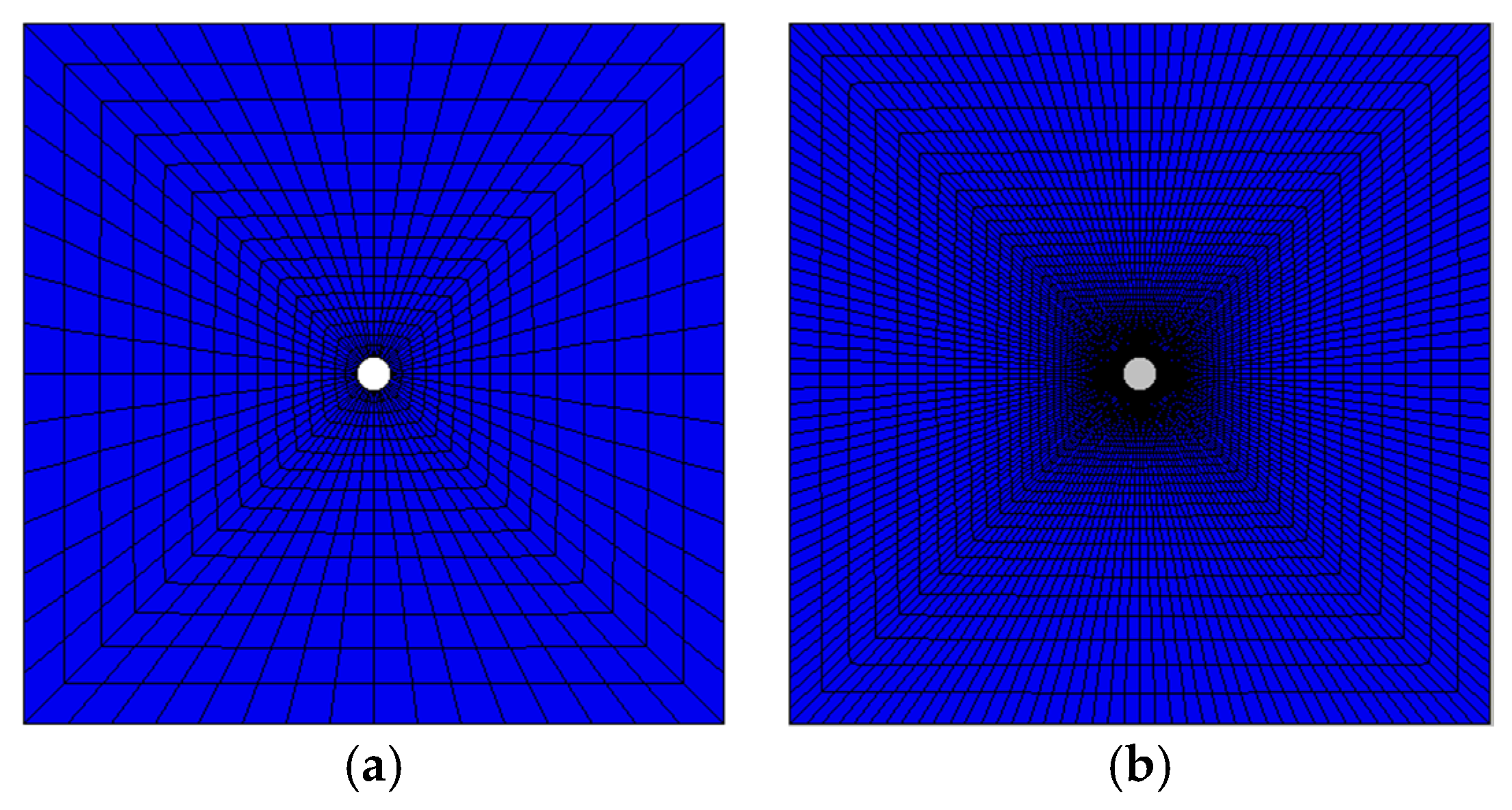
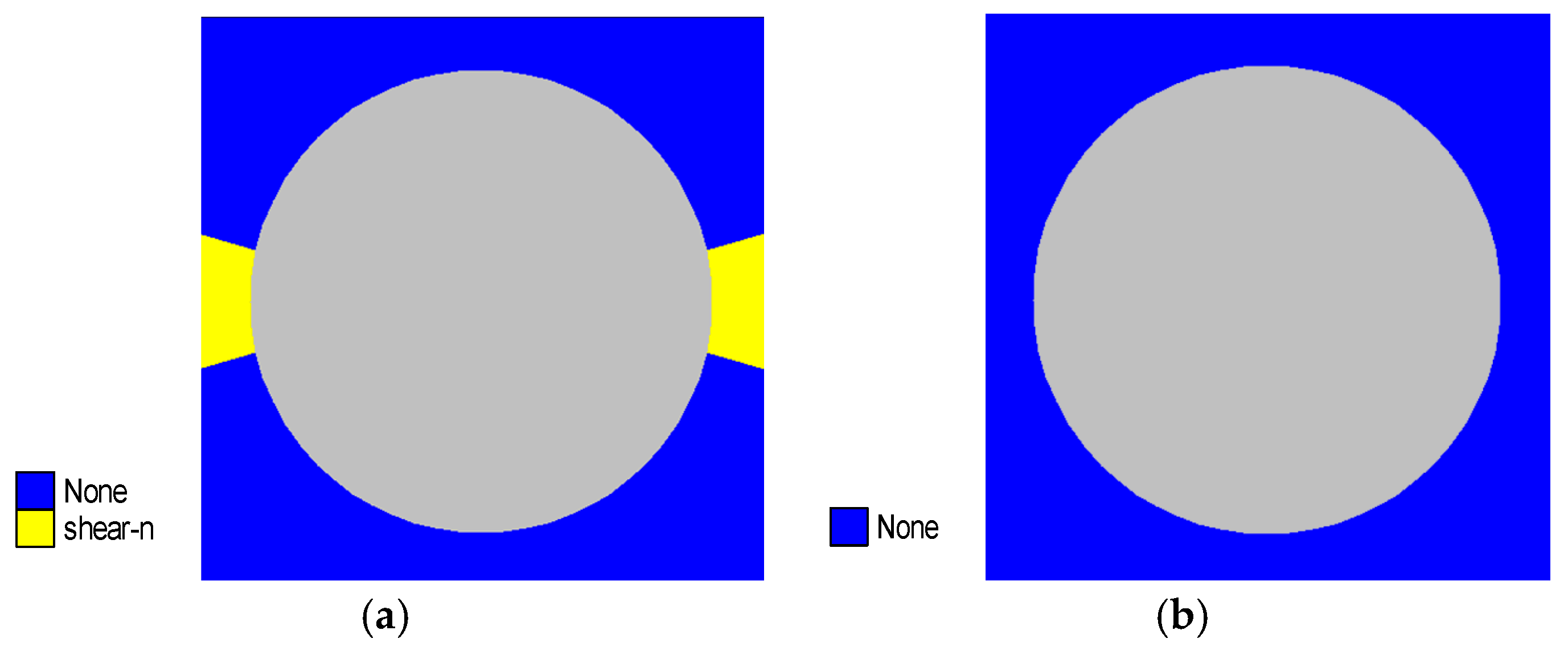
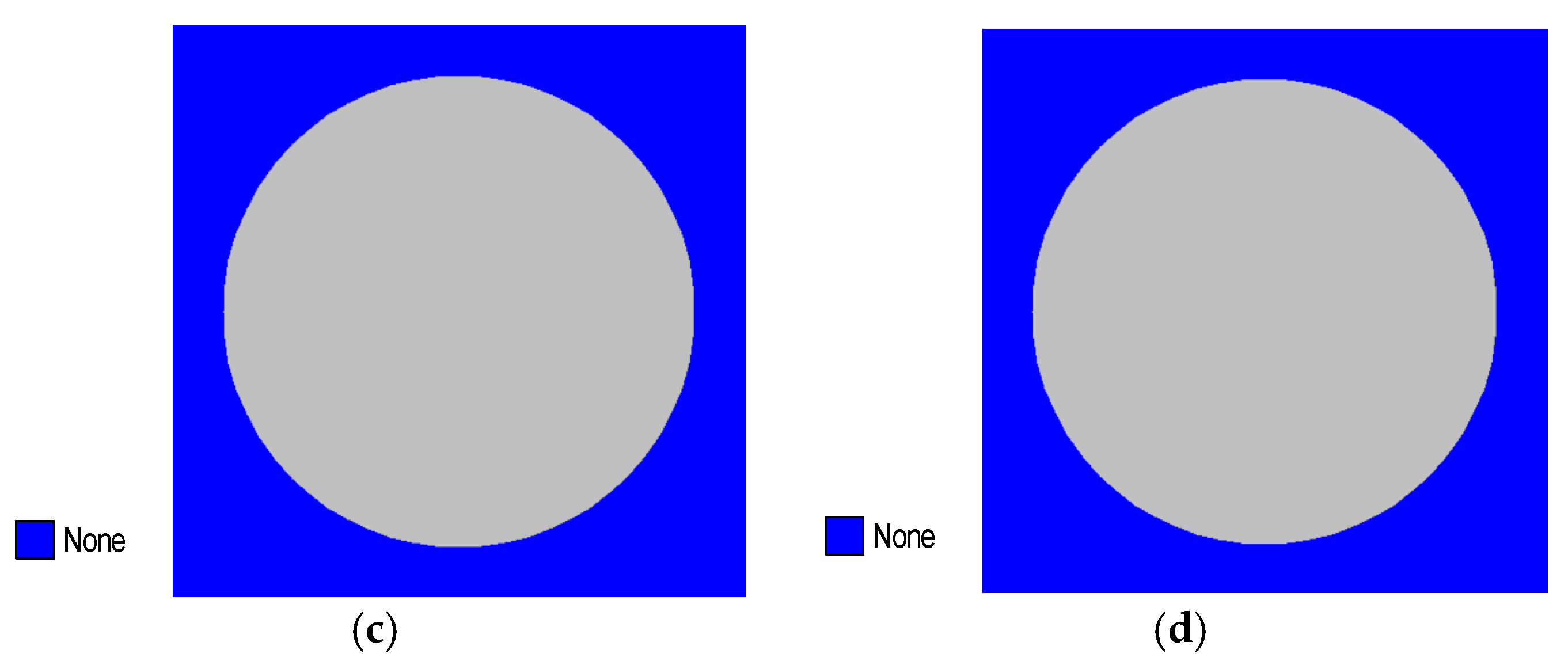

| No. | Density (g/cm3) | NP Size (nm) | NP (wt. %) | pH |
|---|---|---|---|---|
| NP-A | 1.22 | 7 | 30.2 | 10 |
| NP-B | 1.20 | 10–15 | 30.4 | 10 |
| Shale | Nanoparticles | Permeability, nD | Δk, % | ||
|---|---|---|---|---|---|
| Sea Water | BM | BM + NP | |||
| #1 | NP-A | 0.18 | 0.015 | 0.0001 | 99.33 |
| #2 | NP-B | 0.476 | 0.050 | 0.003 | 94.00 |
| Parameter | Value |
|---|---|
| Porosity | 4% |
| Shale density (ρ) | 2600 kg/m3 |
| Viscosity of water (μ) | 1.2 × 10−3 Pa·s |
| Maximum horizontal crustal stress (σH) | 75 MPa |
| Minimum horizontal crustal stress (σh) | 50 MPa |
| Pore fluid pressure (Po) | 25 MPa |
| Drilling fluid pressure (Pf) | 35 MPa |
| Elasticity modulus of shale (E) | 45.9 GPa |
| Poisson’s ratio (μ) | 0.25 |
| Cohesion (C) | 22.73 MPa |
| Friction angle (φ) | 34.8° |
| Tensile strength | 2.94 MPa |
| Shale permeability with sea water | 1.8 × 10−18 cm2 |
| Shale permeability with the BM | 0.15 × 10−18 cm2 |
| Shale permeability with BM plus NP | 0.1 × 10−20 cm2 |
© 2017 by the authors. Licensee MDPI, Basel, Switzerland. This article is an open access article distributed under the terms and conditions of the Creative Commons Attribution (CC BY) license (http://creativecommons.org/licenses/by/4.0/).
Share and Cite
Song, J.; Yuan, Y.; Gu, S.; Yang, X.; Yue, Y.; Cai, J.; Jiang, G. 2D Numerical Simulation of Improving Wellbore Stability in Shale Using Nanoparticles Based Drilling Fluid. Energies 2017, 10, 651. https://doi.org/10.3390/en10050651
Song J, Yuan Y, Gu S, Yang X, Yue Y, Cai J, Jiang G. 2D Numerical Simulation of Improving Wellbore Stability in Shale Using Nanoparticles Based Drilling Fluid. Energies. 2017; 10(5):651. https://doi.org/10.3390/en10050651
Chicago/Turabian StyleSong, Jiwei, Ye Yuan, Sui Gu, Xianyu Yang, Ye Yue, Jihua Cai, and Guosheng Jiang. 2017. "2D Numerical Simulation of Improving Wellbore Stability in Shale Using Nanoparticles Based Drilling Fluid" Energies 10, no. 5: 651. https://doi.org/10.3390/en10050651






